
A mango is an edible stone fruit produced by the tropical tree Mangifera indica. It originated from the region between northwestern Myanmar, Bangladesh, and northeastern India. M. indica has been cultivated in South and Southeast Asia since ancient times resulting in two types of modern mango cultivars: the "Indian type" and the "Southeast Asian type". Other species in the genus Mangifera also produce edible fruits that are also called "mangoes", the majority of which are found in the Malesian ecoregion.

Mangifera is a genus of flowering plants in the cashew family, Anacardiaceae. It contains about 69 species, with the best-known being the common mango. The center of diversity of the genus is in the Malesian ecoregion of Southeast Asia, particularly in Sumatra, Borneo, and the Malay peninsula. They are generally canopy trees in lowland rainforests, reaching a height of 30–40 m (98–131 ft).
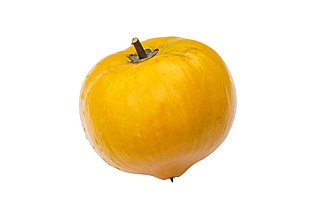
Pouteria campechiana is an evergreen tree native to, and cultivated in, southern Mexico, Belize, Guatemala, and El Salvador. It is cultivated in other countries, such as India, Costa Rica, Brazil, the United States, the Dominican Republic, Australia, Cambodia, Vietnam, Indonesia, Sri Lanka, Nigeria, and the Philippines. The edible part of the tree is its fruit, which is colloquially known as an egg fruit.
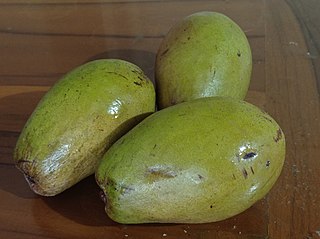
Mangifera caesia is a species of flowering plant in the cashew family, Anacardiaceae. Known in English as jack or white mango, among other names. It belongs to the same genus as the mango and is widely cultivated in areas of Indonesia, Malaysia, Singapore, Brunei, Papua New Guinea and the Philippines.

Spondias dulcis, known commonly as June plum, is a tropical tree, with edible fruit containing a fibrous pit. In the English-speaking Caribbean it is typically known as golden apple and elsewhere in the Caribbean as pommecythere or cythere. In Polynesia it is known as vī.
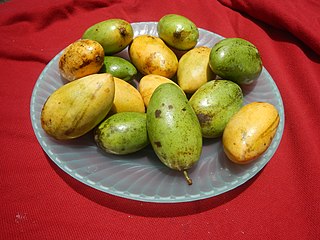
Mangifera altissima, is a species of mango native to the Philippines and surrounding regions in Indonesia, Malaysia, Papua New Guinea and the Solomon Islands. It is not grown commercially but is harvested from the wild in the Philippines. It has small fruits that are pale yellow when ripe and are very sweet, though much more fibrous than commercially cultivated Mangifera indica species like Carabao mangoes. It is threatened by habitat loss.

Mangifera foetida is a species of plant in the family Anacardiaceae.

Mangifera odorata, commonly known as kwini, huani, or Saipan mango, is a species of plant with edible fruit in the family Anacardiaceae. It is similar to the related mango but is characterized by a strong turpentine-like smell on the skin and fibrous flesh. It is native to tropical Southeast Asia, but its exact original native range is unknown because it is only known from cultivated specimens and is believed to be a hybrid of Mangifera indica and Mangifera foetida. It is grown throughout Southeast Asia, from peninsular Thailand, to Malaysia, Indonesia and the southern Philippines. It has also been occasionally cultivated in southern Vietnam and the Marianas Islands.
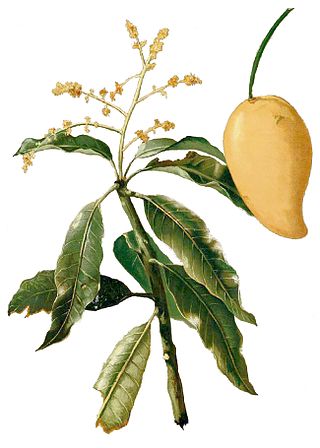
Mangifera sylvatica, also known as the Himalayan mango, pickling mango, or Nepal mango, is a species of plant in the family Anacardiaceae. It is found in Bangladesh, Cambodia, China (Yunnan), India, Myanmar, Nepal, Bhutan and Thailand. It is a tree 6–20 m (20–66 ft) tall. The fruit measure 6 cm–8 cm × 4 cm–5 cm.

Mangifera zeylanica or "Sri Lanka wild mango" is a wild species of mango tree endemic to Sri Lanka. This stately tree is the tallest member of the mango genus, Mangifera, and one of the two tallest trees in the family Anacardiaceae. The mango fruits are edible and have an excellent taste. It is called "aetamba" (ඇටඹ) or "wal amba" in Sinhala and “kaddu-ma” in Tamil. The well-known British botanist and explorer Joseph Dalton Hooker first described the tree in 1876.
Merrillia is a monotypic genus of flowering plants in the citrus family, Rutaceae, containing the single species Merrillia caloxylon. Its English language common names include flowering merrillia, katinga, and Malay lemon. In Malaysia it is called ketenggah and kemuning gajah. The species is native to Malaysia, Thailand, and Sumatra in Indonesia.
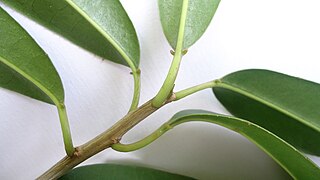
Sapium glandulosum is a species of tree in the family Euphorbiaceae. It is native to the Neotropics from Mexico and the Caribbean south to Argentina, and it has been cultivated elsewhere. It is the most common Sapium species. Its common names include gumtree, milktree, leche de olivo, and olivo macho.
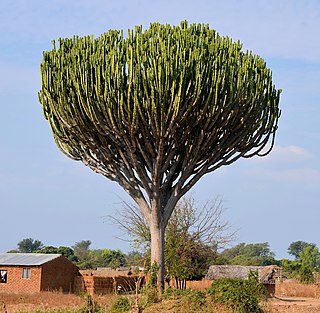
Euphorbia ingens is a species of flowering plant in the family Euphorbiaceae. It is native to dry areas of southern Africa. It is popularly known as the candelabra tree or naboom. Its milky latex can be extremely poisonous and is a dangerous irritant.

Mangifera indica, commonly known as mango, is a species of flowering plant in the family Anacardiaceae. It is a large fruit tree, capable of growing to a height of 30 metres. There are two distinct genetic populations in modern mangoes – the "Indian type" and the "Southeast Asian type".
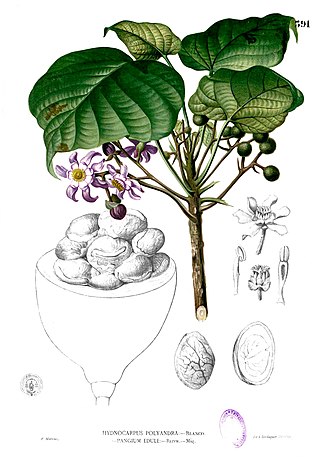
Pangium is a genus containing the sole species Pangium edule, a tall tree native to the mangrove swamps of Southeast Asia. It produces a large poisonous fruit which can be made edible by fermentation. It is dioecious, with male and female flowers produced on separate individuals.

Palaquium gutta is a tree in the family Sapotaceae. The specific epithet gutta is from the Malay word getah meaning "sap or latex". It is known in Indonesia as karet oblong.

Durio graveolens, sometimes called the red-fleshed durian, orange-fleshed durian, or yellow durian, is a species of tree in the family Malvaceae. It is one of six species of durian named by Italian naturalist Odoardo Beccari. The specific epithet graveolens is due to the odor. Although most species of Durio have a strong scent, the red-fleshed type of D. graveolens has a mild scent. It is native to Southeast Asia.

Mangifera gedebe is a species of plant in the family Anacardiaceae. In Javanese it is known as kedepir, in Malay repeh, in Sumatra it has been called gedepir, and in Kalimantan asam rambang or kepi. It is a tree, and can grow up to 30 metres tall and up to 60 centimetres diameter, though it usually grows to about 15 metres tall and 45 centimetres diameter at breast height. The elliptic to oblong-shaped leaves are somewhat leathery in texture and 5 to 23 cm in length and 2 to 6 cm in width. The flowers are white, and have five stamens, of which only one is fertile. It produces obliquely subrotund drupes as fruit, these are 8 to 9 cm in diameter and have a thin layer of fibrous flesh. The seeds, like a walnut, have a very irregularly lobed and folded surface.

Litsea garciae, also known as engkala, engkalak, kangkala, pangalaban, and Borneo avocado, is a flowering tree in the family Lauraceae. It is native to Taiwan, the Philippines, Borneo, the Malay Peninsula, Sumatra, Java, and Sulawesi.

Durio oxleyanus is a perennial plant species of tree in the family Malvaceae. It was once placed in the family Bombacaceae.




















